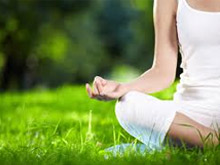 |
The human heart is a highly complicated organ. Though it is just the size of a fist, it pumps around 2,50,000 gallons of blood and beats around four billion times, in a 70 year life span. The total length of blood and lymph vessels in an adult human can run up to 60,000 miles! |
This complex circulatory system runs magnificently on its own for a lifetime, under normal conditions.
Heart Disease
Heart disease is a problem of modern times. Improper lifestyle, faulty diet, lack of exercise and negative thinking, play important roles in triggering heart disease. Research establishes that a person practising yoga and meditation regularly shows a reduction in blood pressure, pulse and overall risk of heart disease.
A complete yoga programme involves proper exercises (asanas), proper breath control (pranayama), proper relaxation (yoga nidra), proper mind control (meditation) and lifestyle modifications.
Asanas
Yogic exercises give a good massage to the hardworking heart. Asanas involve minimal muscular activity. In such a condition, the heart has a tendency to slow down and beat in a controlled manner. When the muscular activity is less, there is minimum production of carbon dioxide. This reduces the levels of stress to the heart. Yoga-asanas stretch the body’s major blood vessels, keeping them free-flowing and elastic. Yoga oxygenates the blood and pushes fresh nutrients to all peripheral vessels and capillaries. Improved circulation aids in more oxygen supply to the brain and all organs, improves alertness, memory, and mood. The vital organs receive a steady supply of the nutrients they need for optimal functioning while you are doing these exercises.
Asanas improve cardiovascular efficiency even in a diseased person. They are an essential component of yoga that brings steadiness and stability to the body. Various asanas immensely help towards a healthy heart. Initially, one can start with simple stretching postures like Tadasana, Vrikshasana, Ardha chakrasana, Ardha kati chakrasana, Trikonasana, Padahastasana. Then slowly start with Vakrasana, Ushtrasana, Naukasana, Bhujangasana, etc. After gaining good flexibility and endurance for strain, one can start the Suryanamskar: a 12-step sequence which itself is a good cardiovascular exercise. But before attempting these, one is advised to seek clearance and proper guidance from a qualified naturopathy and yoga physician.
Pranayama
Taking time to relax and reduce stress is not a luxury but a health promoting and potentially life-extending technique. The breath is the bridge between the body and mind. Our heartbeat responds to our breathing pattern. It gently accelerates when we inhale and slows when we exhale.
Yoga’s emphasis on inhaling slowly, gently, without strain and exhaling completely, is relaxing for the heart muscle. Begin now to become aware of your breath and take time to practise slow, gentle, calm, even breathing. It’s the first step to feeling more relaxed. Yoga breathing exercises teach how to breathe more deeply and rhythmically. Physiologically, it will strengthen respiratory muscles and develop a more efficient exchange of gases. Breathing exercises cause more oxygen to be pushed through the walls of the lungs. Mentally, it will help in improving one’s concentration, willpower, and steadiness.
One can start their practice of pranayama by practising the full yogic breathing in which all three lobes of lungs are expanded by simultaneously expanding the abdomen, thoracic and clavicular muscles while inhaling, and collapsing, while exhaling. Once this deep breathing is adopted one can start with deep, slow breathing pranayama like Nadisodhana or Alternate Nostril Breathing and Both Nostril Breathing. Then, after due practice, one can start with deep, rapid breathing exercises like Kapalabhati.
Yoga Nidra (Savasana)
Yoga Nidra/Savasana or deep relaxation technique teaches how to relax at will, allowing body to release muscle tension almost as it occurs. This is the best of all the techniques, which allows the body to instantly relax at will and prevents from ill effects of stress.
Meditation
Meditation teaches you how to access inner source of strength and personal power, creating a support system that builds confidence and self-esteem, fosters present-moment awareness, increases self-knowledge, and self-awareness.
4 Yogic Lifestyle modifications
Yogic lifestyle advocates:
- Regulated daily routine so as to have minimum stress on the body.
- A strict vegetarian diet: satvik food with low spice, oil and salt which automatically increases dietary fibre, reduces cholesterol, increases HDL or good cholesterol, gives essential vitamins and minerals, and aids in better elimination of toxins.
- Avoidance of all stimulants like tobacco, tea, coffee and alcohol.
- Focusing on ‘internal joy’ (which gives balanced emotions, makes a person calm, confident, composed, energetic, enthusiastic and positive) rather than on materialistic wants and desires (which lead to imbalanced emotions like fear, anxiety, anger and depression).
These are the tenets for cardiac health, and also probably the reason why most cardiologists recommend yoga to their patients. This is further proven by a pioneering study reported in the late 80s by Dr. Dean Ornish, Director of Preventive Medicine and Research Institute, California, USA. The study showed that a strict vegetarian diet, moderate exercise and an hour a day of yoga and meditation could not only prevent heart attacks but could actually reverse atherosclerosis (clogging of arteries). |
 |
Dr. Sreedhar Pulipati is Consultant Physician at Sree Amrutha Nature Cure & Yoga Clinic, Secunderabad. |
|